PolyScience AD07R-20, AD07R-40, AD7LR-20, AD15R-30, AD15R-40 Operating Manual
...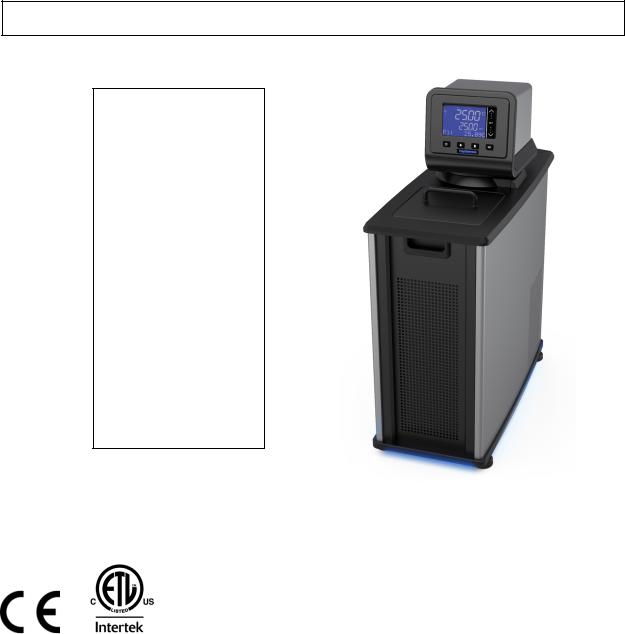
Circulating Baths with Advanced Digital Temperature Controller
Operator’s Manual
Models:
AD07R-20
AD07R-40
AD7LR-20
AD15R-30
AD15R-40
AD20R-30
AD28R-30
AD45R-20
AD07H200
AD15H200
AD20H200
AD28H200
AD06S150
AD10S150
AD28S150
AD29VB3S
AD29VB5R
110-513 PSC/EN 17 November 2014
Table of Contents |
|
Introduction ................................................................................................................................................. |
4 |
PolyScience Circulating Baths with the Advanced Digital Temperature Controller ................................. |
4 |
General Safety Information....................................................................................................................... |
5 |
Safety Recommendations......................................................................................................................... |
6 |
Regulatory Compliance & Testing ............................................................................................................ |
7 |
Unpacking Your Circulator........................................................................................................................ |
8 |
Contents ................................................................................................................................................... |
8 |
Controls & Components............................................................................................................................ |
9 |
Advanced Digital Controller.................................................................................................................. |
9 |
Refrigerating/Heating Baths ............................................................................................................... |
10 |
Heating Only Baths............................................................................................................................. |
11 |
Open Bath Systems (Stainless Steel) ................................................................................................ |
12 |
Viscosity Bath (Polycarbonate) .......................................................................................................... |
12 |
Quick-Start................................................................................................................................................. |
13 |
Installation & Startup ................................................................................................................................ |
15 |
General Site Requirements .................................................................................................................... |
15 |
Adding Liquid to the Bath Reservoir ....................................................................................................... |
15 |
Pump Inlet and Outlet Connections........................................................................................................ |
16 |
External Closed Loop Circulation ........................................................................................................... |
17 |
Open Loop Circulation ............................................................................................................................ |
17 |
Refrigeration Control Connections (Refrigerating/Heating Circulators only).......................................... |
18 |
Electrical Power ...................................................................................................................................... |
18 |
Refrigerating/Heating Circulators ....................................................................................................... |
18 |
Heat Only Circulators and Open Bath Systems ................................................................................. |
19 |
Communication....................................................................................................................................... |
20 |
USB Communication .......................................................................................................................... |
21 |
Ethernet .............................................................................................................................................. |
21 |
RS232 / RS485 Serial Communication .............................................................................................. |
21 |
External (P2) Temperature Probe .......................................................................................................... |
21 |
Controller Setup...................................................................................................................................... |
22 |
Power ................................................................................................................................................. |
22 |
Safety Set Temperature ..................................................................................................................... |
23 |
Normal Operation...................................................................................................................................... |
24 |
Keys and Controls .................................................................................................................................. |
24 |
Turning Your Circulator ON .................................................................................................................... |
24 |
Main Operational Display........................................................................................................................ |
25 |
Set-Up Sub-Menus ................................................................................................................................. |
27 |
Adjusting the Temperature Set Point...................................................................................................... |
28 |
Selecting the Temperature Unit.............................................................................................................. |
29 |
Selecting the Pump Speed ..................................................................................................................... |
30 |
Setting the High Limit Temperature........................................................................................................ |
31 |
Setting the Low Limit Temperature......................................................................................................... |
32 |
Setting the Differential Temperature....................................................................................................... |
33 |
Setting the Auto Cool Temperature ........................................................................................................ |
34 |
Setting the Specific Heat Capacity (SHC) .............................................................................................. |
35 |
Selecting Internal or External Control..................................................................................................... |
36 |
Calibrating Your Circulator (Offset) ........................................................................................................ |
37 |
Displaying the Safety Set Temperature.................................................................................................. |
38 |
Selecting a Remote Communication and Control Protocol .................................................................... |
39 |
Using the Timer ...................................................................................................................................... |
40 |
Entering a Password............................................................................................................................... |
41 |
Enabling / Disabling Data Logging ......................................................................................................... |
42 |
110-513 PSC/EN |
2 |
Selecting the Operational Language ...................................................................................................... |
43 |
Setting Auto Restart................................................................................................................................ |
44 |
Resetting the Factory Default Values ..................................................................................................... |
44 |
Changing Your Circulator's Viewing Angle............................................................................................. |
45 |
Inert Gas Purge ...................................................................................................................................... |
45 |
Tap Water Cooling.................................................................................................................................. |
45 |
Reservoir Cover Storage ........................................................................................................................ |
46 |
Display Messages and Alarms ................................................................................................................ |
47 |
Routine Maintenance & Troubleshooting............................................................................................... |
48 |
Maintaining Clear Bath Water................................................................................................................. |
48 |
Draining the Bath Reservoir ................................................................................................................... |
48 |
Refrigerated / Heating and Heat only Circulating Baths..................................................................... |
48 |
Polycarbonate Viscosity Baths ........................................................................................................... |
49 |
Checking the Over-Temperature / Low Liquid Level Safety Systems.................................................... |
50 |
Over-Temperature Protection............................................................................................................. |
50 |
Low Liquid-Level Protection ............................................................................................................... |
50 |
Cleaning Your Circulator......................................................................................................................... |
51 |
Temperature Controller ...................................................................................................................... |
51 |
Bath Reservoir.................................................................................................................................... |
51 |
Pump Impeller .................................................................................................................................... |
51 |
Condenser, Air Vents, and Reusable Filter (Refrigerating / Heating Circulators only) ...................... |
51 |
Temperature Controller Removal and Re-Installation ............................................................................ |
52 |
Removal ............................................................................................................................................. |
52 |
Re-Installation..................................................................................................................................... |
53 |
Viewing Component Operating Time...................................................................................................... |
54 |
Troubleshooting Chart ............................................................................................................................ |
55 |
Technical Information............................................................................................................................... |
57 |
Performance Specifications.................................................................................................................... |
57 |
Reservoir Fluids...................................................................................................................................... |
58 |
Application Notes.................................................................................................................................... |
60 |
Tubing and Fitting Temperature Ranges................................................................................................ |
60 |
Fluid Compatibility .................................................................................................................................. |
60 |
RS232/RS485 Configuration .................................................................................................................. |
61 |
RS232/RS485 Communications............................................................................................................. |
63 |
USB Data Logging .................................................................................................................................. |
65 |
USB B Setup, Monitoring, and Control ................................................................................................... |
65 |
Initial Setup......................................................................................................................................... |
65 |
Monitoring and Control ....................................................................................................................... |
66 |
Configuring the Ethernet Connection ..................................................................................................... |
66 |
Direct Computer to Controller Configuration ...................................................................................... |
66 |
Wired or Wireless Network Configuration .......................................................................................... |
66 |
Equipment Disposal (WEEE Directive) ................................................................................................... |
70 |
Replacement Parts & Accessories.......................................................................................................... |
71 |
PolyScience Circulating Bath Fluids ...................................................................................................... |
73 |
Service & Technical Support ................................................................................................................... |
73 |
Warranty..................................................................................................................................................... |
74 |
110-513 PSC/EN |
3 |

Introduction
Thank you for choosing a PolyScience Circulating Bath. It is intended for the precise temperature control of suitable liquids in a reservoir. Extremely easy to use and maintain, your Circulating Bath combines design innovation with highly intuitive operation to deliver convenient and reliable liquid temperature control for a wide range of applications.
WARNING: PolyScience Circulating Baths are not intended for directly controlling the temperature of foods, pharmaceuticals, medicines, or other objects which may be ingested by or injected in humans or animals. Any such objects must be isolated from contact with the bath fluid and bath surfaces.
Here are some of the features that make your Circulating Bath so user-friendly:
•Simple, intuitive operation
•Extra-large digital readout that displays actual and set point temperature simultaneously
•Powerful variable speed duplex pump with openand closed-loop external circulation capability
•180° viewing radius (Swivel 180™ rotating control head)
•DuraTop™ heat and chemical resistant top plate
•LidDock™ self-storing reservoir cover (integrated baths only)
•Built-in temperature protection
•Suitable for use with Class III flammable fluids per DIN 12876-1
It will take you very little time to get your new Circulating Bath installed and running. This Operator’s Manual is designed to guide you quickly through the process. We recommend that you read it thoroughly before you begin.
PolyScience Circulating Baths with the Advanced Digital Temperature Controller
Model Type |
Reservoir |
Temperature Range |
||
Capacity |
°C |
°F |
||
|
||||
|
|
|
|
|
AD07R-20 Refrigerating / Heating Bath |
7 liters |
-20° to 200°C |
-4° to 392°F |
|
|
|
|
|
|
AD07R-40 Refrigerating / Heating Bath |
7 liters |
-40° to 200°C |
-40° to 392°F |
|
|
|
|
|
|
AD7LR-20 Refrigerating / Heating Bath |
7 liters |
-20° to 200°C |
-4° to 392°F |
|
|
|
|
|
|
AD15R-30 Refrigerating / Heating Bath |
15 liters |
-30° to 200°C |
-22° to 392°F |
|
|
|
|
|
|
AD15R-40 Refrigerating / Heating Bath |
15 liters |
-40° to 200°C |
-40° to 392°F |
|
|
|
|
|
|
AD20R-30 Refrigerating / Heating Bath |
20 liters |
-30° to 200°C |
-22° to 392°F |
|
|
|
|
|
|
AD28R-30 Refrigerating / Heating Bath |
28 liters |
-30° to 200°C |
-22° to 392°F |
|
|
|
|
|
|
AD45R-20 Refrigerating / Heating Bath |
45 liters |
-25° to 135°C |
-13° to 275°F |
|
|
|
|
|
|
AD07H200 Heating Only Bath |
7 liters |
Ambient +10° to 200°C |
Ambient +20° to 392°F |
|
AD15H200 Heating Only Bath |
15 liters |
Ambient +10° to 200°C |
Ambient +20° to 392°F |
|
|
|
|
|
|
AD20H200 Heating Only Bath |
20 liters |
Ambient +10° to 200°C |
Ambient +20° to 392°F |
|
|
|
|
|
|
AD28H200 Heating Only Bath |
28 liters |
Ambient +10° to 200°C |
Ambient +20° to 392°F |
|
|
|
|
|
|
AD06S150 Open Bath System |
6 liters |
Ambient +10° to 150°C (1) |
Ambient +20° to 302°F (1) |
|
AD10S150 Open Bath System |
10 liters |
Ambient +10° to 150°C (1) |
Ambient +20° to 302°F (1) |
|
AD20S150 Open Bath System |
20 liters |
Ambient +10° to 150°C (1) |
Ambient +20° to 302°F (1) |
|
AD28S150 Open Bath System |
28 liters |
Ambient +10° to 150°C (1) |
Ambient +20° to 302°F (1) |
|
AD29VB5R Polycarbonate Viscosity |
29 liters |
Ambient +10° to 85°C (2) |
Ambient +20° to 185°F (2) |
|
AD29VB3S Polycarbonate Viscosity |
29 liters |
Ambient +10° to 85°C (2) |
Ambient +20° to 185°F (2) |
|
1.Maximum operating temperature at which ±0.01°C temperature stability can be maintained; Advanced Digital Controller is capable of higher temperatures.
2.Maximum operating temperature for polycarbonate tank. Advanced Digital Controller is capable of higher temperatures.
110-513 PSC/EN |
4 |
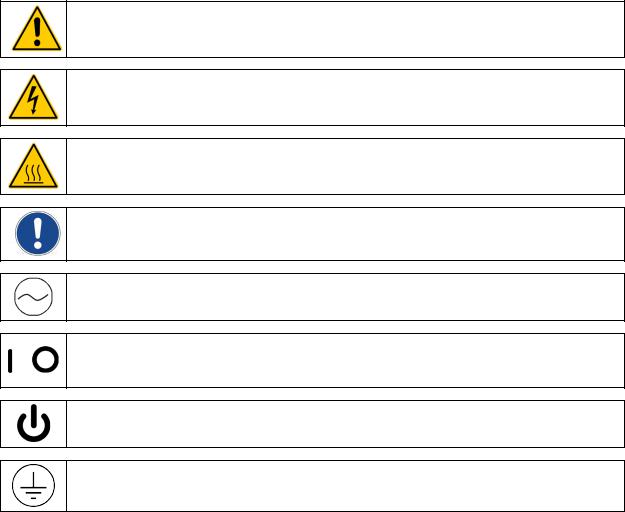
General Safety Information
When installed, operated, and maintained according to the directions in this manual and common safety procedures, your Circulating Bath should provide safe and reliable temperature control. Please ensure that all individuals involved in the installation, operation, or maintenance of this Circulating Bath read this manual thoroughly prior to working with the unit.
This symbol alerts you to a wide range of potential dangers.
This symbol advises you of danger from electricity or electric shock.
This symbol indicates that a hot surface may be present.
This symbol marks information that is particularly important.
This symbol indicates alternating current.
/These symbols on the Power Switch / Circuit Breaker indicate that they place the main power supply ON / OFF.
This symbol on the Power Key indicates that it places the unit in a standby mode. It DOES NOT fully disconnect the unit from the power supply.
This symbol indicates a protective conductor terminal.
Read all instructions pertaining to safety, set-up, and operation.
Proper operation and maintenance is the user’s responsibility.
110-513 PSC/EN |
5 |
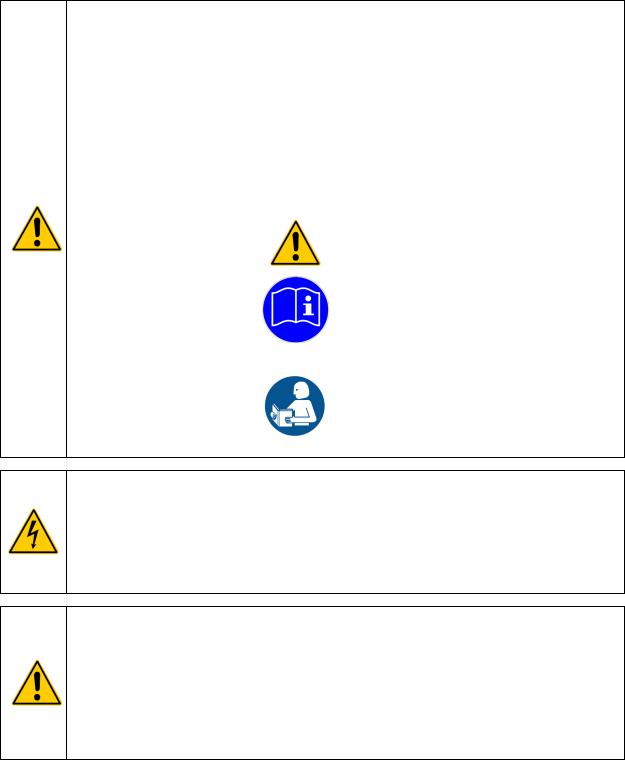
Safety Recommendations
To prevent injury to personnel and/or damage to property, always follow your workplace’s safety procedures when operating this equipment. You should also comply with the following safety recommendations:
WARNING:
•This Circulating Bath is suitable for use with Class III flammable fluids per DIN 12876-1. A fire hazard may be present.
•Be aware of the chemical hazards that may be associated with the bath fluid used. Observe all safety warnings for the fluids used as well as those contained in the material safety data sheet.
•Explosive gas mixtures may accumulate if used with insufficient ventilation. Use this Circulating Bath in a well ventilated area or beneath a suitable fume hood only.
•Use only recommended bath fluids; see Technical Information in the rear of this manual for recommended fluids.
•Use only non-acid bath fluids.
WARNING: When using Class III flammable fluids per DIN 12876-1, the user must attach the following warning labels to the front of the unit so that they are well visible:
Warning Label |
|
Danger Area. |
W09 |
|
Attention! Observe instructions |
Colors: Yellow/black |
|
(operating manual, safety data sheet) |
|
|
|
Mandatory Label |
|
Carefully read the user information prior to |
M018 |
|
beginning operation. |
Colors: Blue/white |
|
Scope: EU |
or |
|
|
Semi S1-0701 |
|
Carefully read the user information prior to |
Table A1-2 #9 |
|
beginning operation. |
Colors: Blue/white |
|
Scope: NAFTA |
|
|
|
WARNING:
•Always connect the power cord on this Circulator to a grounded (3-prong) power outlet. Make certain that the outlet is the same voltage and frequency as your unit.
•Never operate the Circulator with a damaged power cord.
•Always turn the Circulator OFF and disconnect mains power before performing any maintenance or service.
WARNING:
•Never operate the Circulator without bath fluid in the reservoir. Periodically check the reservoir to ensure that the liquid depth is within acceptable levels. Always refill the reservoir using the same bath fluid type that is already in the reservoir. Bath oil must not contain any water contaminants and should be preheated to the actual bath temperature before adding as there is an explosion hazard at high temperatures.
•Always drain all fluid from the reservoir before moving or lifting your Circulator. Be sure to follow your organization’s procedures and practices regarding the safe lifting and relocation of heavy objects.
110-513 PSC/EN |
6 |

WARNING:
•Always allow the bath fluid to cool to ambient temperature before draining.
•The reservoir cover, top deck, and/or external pump connections may become hot with continuous use. Exercise caution when touching these parts.
•Always keep within the 85°C maximum operating temperature limit if using a polycarbonate tank.
WARNING: It is the user’s responsibility to properly decontaminate the unit in the event hazardous materials are spilled on exterior or interior surfaces. Consult manufacturer if there is any doubt regarding the compatibility of decontamination or cleaning agents.
Regulatory Compliance and Testing
This equipment is compliant with the European Directive 2002/95/EC and its latest amendments on Restrictions on Hazardous Substances (RoHS) and below the given limits of hazardous substances.
ETL Intertek (60 Hz units)
UL 61010-1 / CSA C22.2 No. 61010-1 — Safety Requirements for Measurement, Control, and Laboratory Use; Part 1: General Requirements
UL 61010A-2-010 / CSA C22.2 No. 61010-2-010:04 — Safety Requirements for Measurement, Control, and Laboratory Use; Part 2-010: Particular Requirements for Laboratory Equipment for the Heating of Materials
UL 61010A-2-051 / CSA C22.2 No. 61010-2-051:04 — Safety Requirements for Measurement, Control, and Laboratory Use; Part 2-051: Particular Requirements for Laboratory Equipment for the Mixing and Stirring
CE (all units)
EC Low Voltage Directive 2006/95/EC
EC Electromagnetic Compatibility Directive 2004/108/EC
IEC 61010-1-2001
IEC 61010-2-2001
IEC 61326:2005 / EN 61326 : 2006
110-513 PSC/EN |
7 |

Unpacking Your Circulator
Your Circulator was packed in a special carton or cartons. You should keep the packaging, along with all packing materials, until the unit has been installed and you are certain it is working properly.
CAUTION: Remove any loose packing material that may have fallen into the heater/pump housing during shipping. Before powering up, check that nothing remains around the heater or Circulator pump.
We recommend that you begin using your Circulator immediately to confirm proper operation, since beyond one week you may be eligible for warranty repair only (rather than replacement). You’ll find complete warranty information in the back of this manual.
In the unlikely event that the unit was damaged or does not operate properly, contact the transportation company, file a damage claim, and contact the company where your Circulator was purchased.
Contents
The items included with your Circulator will vary depending on which model Circulating Bath you purchased.
|
Refrigerating / |
|
Heating Only |
|
Open Bath |
Viscosity |
|
Heating Bath |
|
Bath |
|
System |
Bath |
Resource Disk with |
● |
|
● |
|
● |
● |
Operator’s Manual |
|
|
||||
|
|
|
|
|
|
|
Reservoir Lid |
● |
|
● |
|
● |
N/A |
|
|
|
|
|
|
|
3-ft / 0.91 m IEC to |
● |
|
N/A |
|
N/A |
N/A |
IEC Power Cord |
|
|
||||
|
|
|
|
|
|
|
6-ft / 1.82 m IEC to |
● |
|
● |
|
● |
● |
Mains Power Cord |
|
|
||||
|
|
|
|
|
|
|
Refrigeration Control |
● |
|
N/A |
|
N/A |
N/A |
Cable |
|
|
||||
|
|
|
|
|
|
|
Fittings |
1/4 in. NPT to 3/16 in. barbed adapter (1) |
|
||||
|
1/4 in. NPT to 1/4 in. barbed adapter (1) |
|
|
|||
|
1/4 in. NPT to 3/8 in. barbed adapter (1) |
|
|
|||
|
|
1/4 in. NPT to M16 barbed adapter (2) |
|
|
||
Cooling Coil |
N/A |
|
Integral |
|
Optional |
● |
Certificate of |
● |
|
● |
|
● |
● |
Compliance |
|
|
||||
|
|
|
|
|
|
|
Quick-Start Guide |
● |
|
● |
|
● |
● |
|
|
|
|
|
|
|
1.60Hz and 50Hz models
2.50Hz models only
110-513 PSC/EN |
8 |

Controls and Components
Advanced Digital Controller
3.75” (9.5 cm)
Color LCD
Power Key
Home Key
Power Switch /
Circuit Breaker (located on Refrigeration Power Module on Refrigerating/Heating Circulators)
Safety Set
Thermostat
IEC Electrical
Connection
IEC Power Cord
Fluid Inlet Connection
Inert Gas Injection Port
Touch Scroll Bar
Set Key
Menu Key
Swivel 180
Latch Release
USB A Connection
USB B Connection
Ethernet Connection
RS232/RS485 Serial Port
External (P2)
Temperature Probe
Connection
Refrigeration Control
Connection (functional on
Refrigerating/Heating
Circulators only)
Fluid Outlet Connection
Bypass Hose
110-513 PSC/EN |
9 |
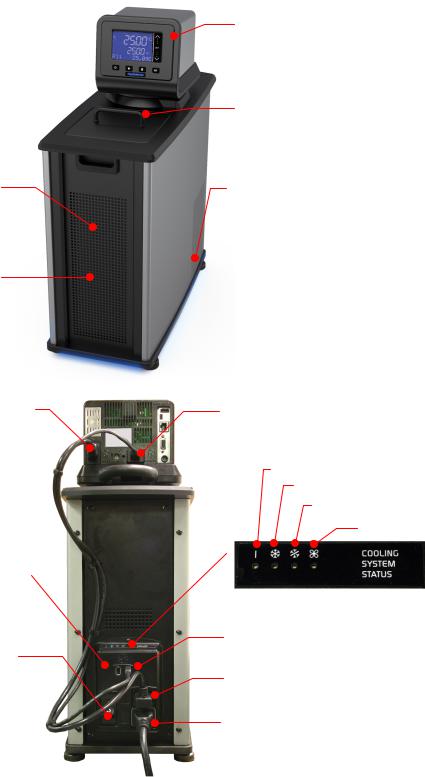
Refrigerating/Heating Baths
Reservoir Drain Valve and Port
(behind access panel) Side access on AD7LR-20)
Washable Air Filter
(behind access panel)
IEC Power Connection to
Refrigeration Power Module
Refrigeration Power Module
Power Switch / Circuit Breaker
Advanced Digital
Temperature Controller
Reservoir Cover
Drain Valve and Port
(right side on AD7LR-20 only)
Refrigeration Control
Connection
Power
Cooling
Cooling Fault
Fan
Cooling System Status Display
Refrigeration Control Connection
IEC Power Connection to Controller
IEC Power Connection to Mains
110-513 PSC/EN |
10 |
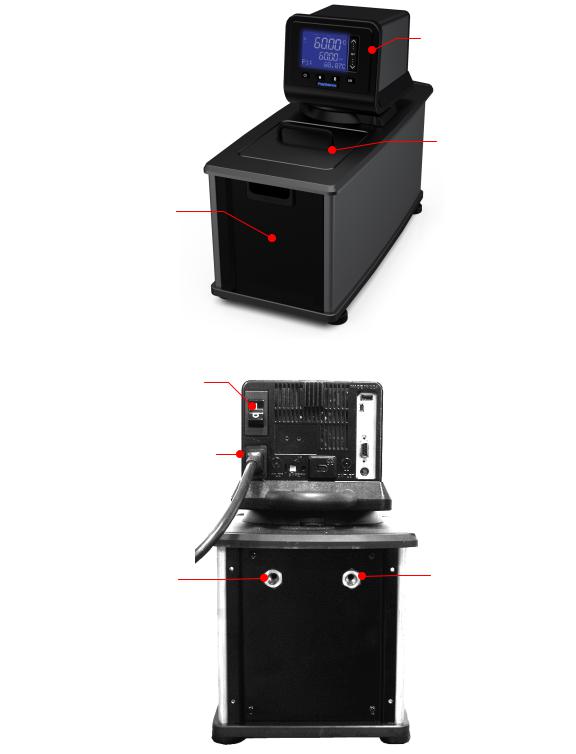
Heating Only Baths
Reservoir Drain Valve and Port
(behind access panel)
Power Switch / Circuit Breaker
IEC Connection to Mains
Tap Water Cooling Connection
(inlet)
Advanced Digital
Temperature Controller
Reservoir Cover
Tap Water Cooling Connection
(outlet)
110-513 PSC/EN |
11 |
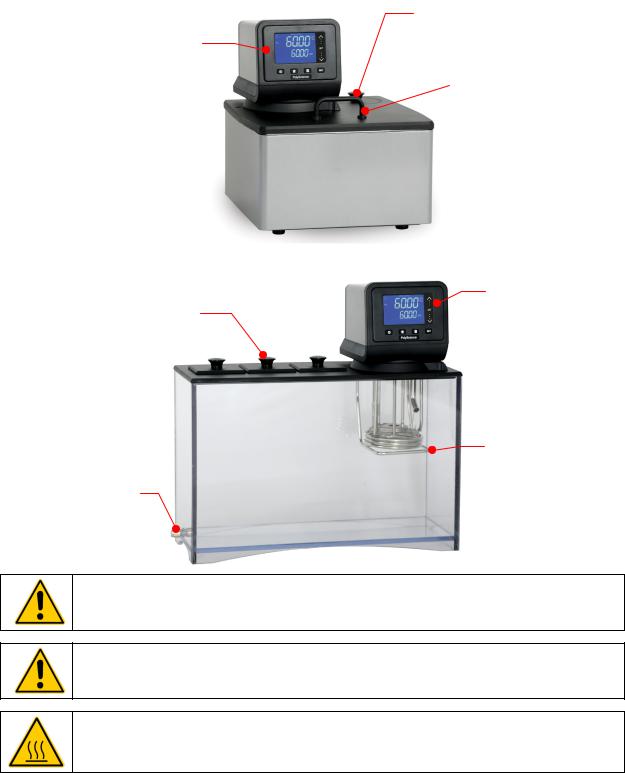
Open Bath Systems (Stainless Steel)
Advanced Digital
Temperature Controller
Viscosity Bath (Polycarbonate)
Lidded Viscometer Openings
Reservoir Drain Port
Cooling Coil Opening with Cover
(10L, 20L, and 28L models)
Reservoir Cover
Advanced Digital
Temperature
Controller
Tap Water Cooling
Coil
WARNING: The top deck on Open Bath Systems and Viscosity Baths is not attached. Do not remove deck while Circulator is operating. Do not lift bath by grasping the Temperature Controller or top deck. Always disconnect electrical power and drain fluid from bath before moving.
WARNING: The PolyScience Advanced Digital Temperature Controller is designed for use with Class III flammable liquids per DIN 12876-1; however, we strongly recommend that Open Bath Systems and Viscosity Baths be used only with non-flammable fluids.
WARNING: To avoid the potential for burns, allow the Circulator to cool completely before cleaning or performing any maintenance.
110-513 PSC/EN |
12 |
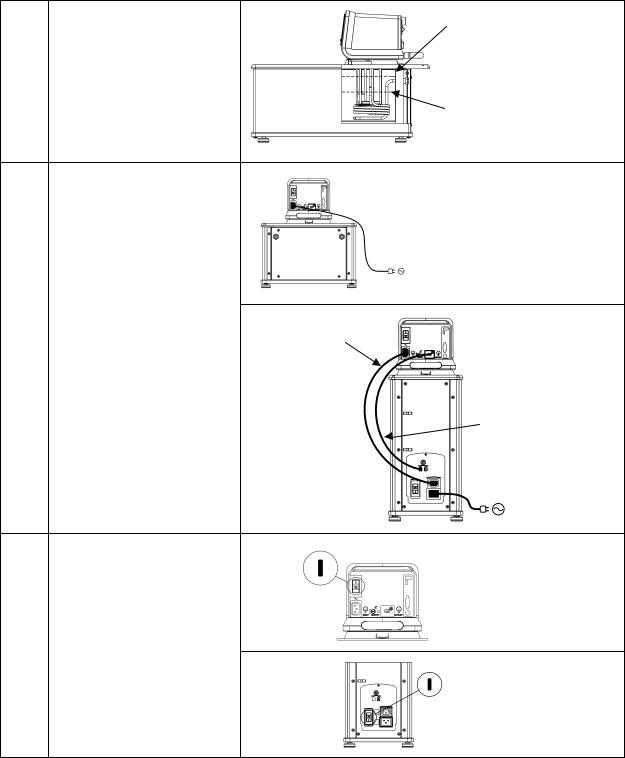
Quick-Start
Unless otherwise specified, quick-start instructions apply to all models. See Installation and Startup for additional information.
Maximum: 1 in. / 2.54 cm below underside of top deck
1 Fill reservoir with fluid
Minimum: 3.0 in. / 7.6 cm below underside of top deck
Heating only models
2 |
Connect all power cords and |
IEC power cord |
Refrigerating / Heating |
|
|
control cables |
from Controller |
|
models |
|
|
|
|
to Refrigeration |
|
|
|
|
|
|
|
|
|
|
|
Power Module |
|
|
|
|
|
|
|
|
|
|
|
|
|
Refrigeration control |
|
|
|
|
|
cable |
|
|
|
|
|
|
|
Heating only models
3Place Power Switch / Circuit Breaker in ON position
Refrigerating / Heating
models
110-513 PSC/EN |
13 |
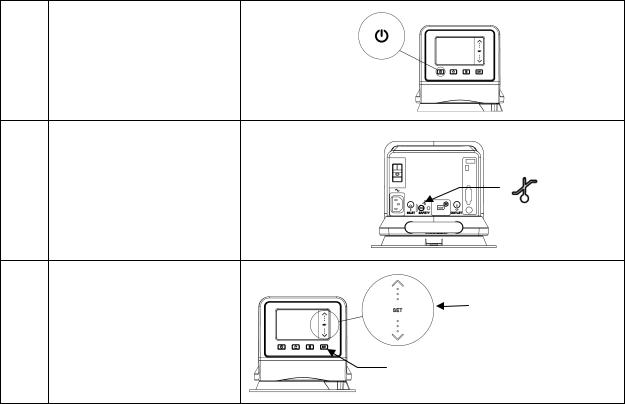
4 Turn Controller “ON”
5 |
Set safety thermostat |
|
|
|
|
|
6B. |
|
Enter temperature |
|
Touch and hold or slide |
6 |
|
finger up/down scroll bar |
|
set point |
|
||
|
|
|
|
|
|
|
|
|
|
6A. |
|
|
|
Press SET |
|
|
|
|
|
110-513 PSC/EN |
14 |
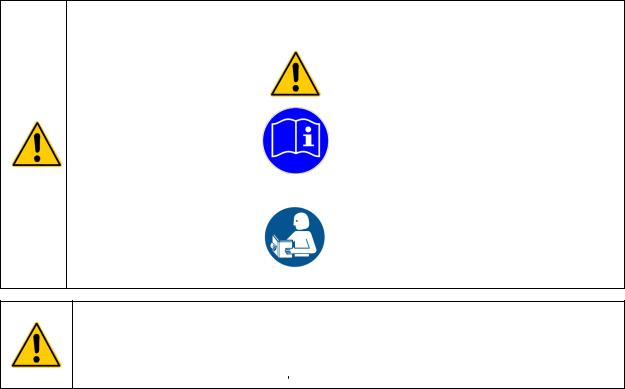
Installation and Startup
Your Circulating Bath with Advanced Digital Temperature Controller is designed to be simple to set-up and install. The only tools required are a No.1 Phillips-head screwdriver and a container for adding water or other suitable fluid to the bath reservoir.
General Site Requirements
Locate your Circulator on a level surface free from drafts and direct sunlight. Do not place it where there are corrosive fumes, excessive moisture, high room temperatures, or in excessively dusty areas.
Refrigerating / Heating Circulators must be 10.2 cm / 4 inches or more away from walls or vertical surfaces so that airflow is not restricted.
Avoid voltage drops by using properly grounded power outlets wired with 14 gauge or larger diameter wire and if possible, be close to the power distribution panel. The use of extension cords is not recommended; this will reduce the potential for problems caused by low line voltage.
Adding Liquid to the Bath Reservoir
WARNING: When using Class III flammable fluids per DIN 12876-1, the user must attach the following warning labels to the front of the unit so that they are well visible:
Warning Label |
|
Danger Area. |
W09 |
|
Attention! Observe instructions |
Colors: Yellow/black |
|
(operating manual, safety data sheet) |
|
|
|
Mandatory Label |
|
Carefully read the user information prior to |
M018 |
|
beginning operation. |
Colors: Blue/white |
|
Scope: EU |
or |
|
|
Semi S1-0701 |
|
Carefully read the user information prior to |
Table A1-2 #9 |
|
beginning operation. |
Colors: Blue/white |
|
Scope: NAFTA |
|
|
|
WARNING: See Technical Information in the rear of this manual for a list of compatible liquids. WARNING: Read the safety data sheet for the bath fluid being used carefully before filling reservoir.
WARNING: If the proper fluid level is not maintained, the heater coil may become exposed and possibly damaged (fluid level too low) or the bath may overflow (fluid level too high).
The liquid in the reservoir should be maintained at a depth between 1 inch / 2.54 cm and 3.0 inches / 7.6 cm below the underside of the bath’s top deck. Upon start up, it may be necessary to add fluid to the bath to compensate for the fluid required for external circulation. Likewise, be sure to compensate for fluid displacement when placing samples or other materials in the Circulator’s reservoir.
110-513 PSC/EN |
15 |
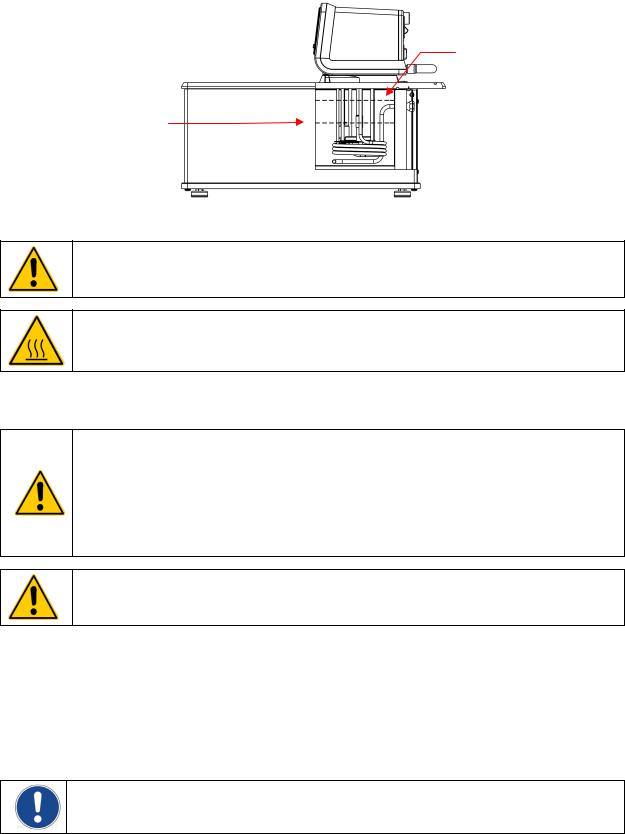
Maximum Fluid Level =
1 inch / 2.54 cm below underside of top deck
Minimum Fluid Level =
3.0 inches / 7.6 cm below underside of top deck
WARNING: Always drain all fluid from the reservoir before moving or lifting your Circulator. Be sure to follow your organization’s procedures and practices regarding the safe lifting and relocation of heavy objects.
WARNING: To avoid the potential for burns, allow the Circulator to cool completely before cleaning or performing any maintenance.
Pump Inlet and Outlet Connections
WARNING: When connecting tubing to an external application, it is the user’s responsibility to make sure that the tubing and fittings connected to the Circulator are suitable for the fluid being used and the temperature range of operation.
CAUTION: The Circulator’s bypass tubing is secured to the fluid inlet and outlet connections by high temperature nylon hose clamps, which can be removed by carefully cutting them with diagonal cutters.
CAUTION: Secure the tubing to the inlet and outlet fittings using hose clamps with a minimum ID of 7/8 inch (22 mm). Do not operate the unit without hose clamps.
WARNING: If the Circulating Bath will not be used for external circulation, the inlet and outlet ports should remain connected using the Buna N bypass tubing provided with the unit.
The pump inlet and outlet ports are female ¼ inch NPT connections that permit use of barbed tubing adapters or hard plumbing fittings. ½ inch (13 mm) ID tubing may also be slid over these connections and held in place with a hose clamp (minimum 7/8 inch / 22 mm ID).
If the pump inlet and outlet are not used for external circulation, the Bypass Tubing provided with the unit should be left in place in order to optimize fluid mixing within the reservoir.
The nylon barbed tubing adapter fittings supplied with the unit are intended for applications from
-40° to 93°C. For applications above 93°C, brass, stainless steel, or Teflon® fittings are recommended. ¼ inch NPT to M16 stainless steel male adapter fittings are provided with all 50Hz models.
NOTE: The use of quick-connect fittings is not recommended as they typically restrict flow rate.
110-513 PSC/EN |
16 |
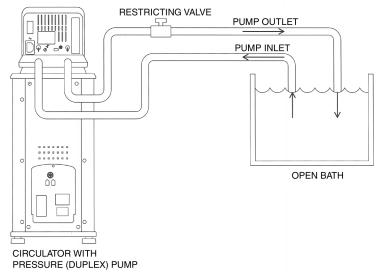
External Closed Loop Circulation
Connect the pump inlet and outlet to the external apparatus. To maintain adequate flow, avoid restrictions in the tubing. When connecting the Circulator to more than two closed loops, the use of a manifold made of “Y” adapters to divide the fluid into multiple banks is recommended. After setting up multiple closed loops, check for adequate flow at the return manifold of each loop and check that the bath fluid is at an adequate level. A booster pump may be added to closed loops without damaging the Circulator’s pump.
The temperature control stability of a closed loop system is better at the external apparatus than in the Circulator reservoir (provided the control point of the apparatus represents a constant load and is well insulated). For example, if you circulate fluid through a viscometer at 50°C, the temperature variation observed in the Circulator reservoir may be ±0.1°C while the temperature variation in the viscometer may be only ±0.05°C.
Although temperature stability is generally better at the external apparatus control point, depending on the length of tubing used and the efficiency of the insulation, the actual temperature reading at the external apparatus may be slightly different than the temperature reading at the Circulator reservoir.
Open Loop Circulation
The duplex (pressure/suction) pump permits circulation to and from an external open bath. To prevent siphoning when the Circulating Bath is turned off, position both baths so that the two fluid levels are at the same elevation.
Connect the pump inlet and outlet to the external bath using tubing of the same diameter and length. The same size fittings should also be used on both the inlet (suction) and outlet (pressure). This helps ensure a balanced flow. A restricting valve or pinch clip should be installed in the pressure (outlet) tubing and adjusted to match the return suction (inlet) flow rate. Cut the external end of the suction tube into a “V” shape so that the tube will not seal itself against the wall of the external tank. Both the pressure and suction tubing should be securely fastened to the external tank to prevent movement during use.
When using flexible tubing, the suction tubing must have a wall thickness that will not collapse under vacuum, particularly when going around bends.
Circulating Bath Height Regulation — Position the ends of the pressure and suction tubes at the desired maximum fluid level in the external bath and fill the bath to that level. Fill the Circulating Bath to a height one inch (25mm) below the top of the reservoir. Start the pump and adjust the restricting valve/pinch clip on the pressure tubing until the liquid height in both baths remains constant. Add fluid to the baths as needed to compensate for the fluid in the inlet and outlet lines.
110-513 PSC/EN |
17 |
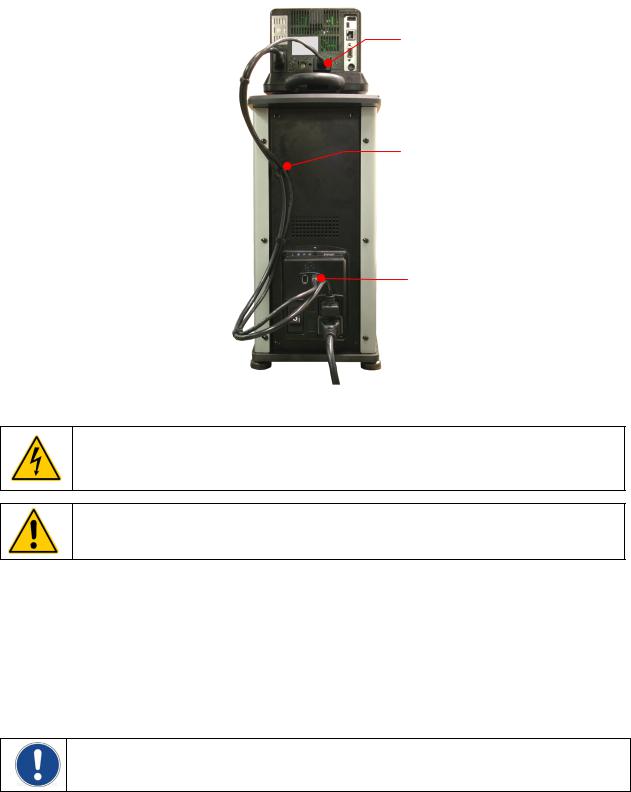
Refrigeration Control Connections (Refrigerating/Heating Circulators only)
Refrigeration Control Connection
Refrigeration Control Cable
Refrigeration Control Connection
Electrical Power
WARNING: The Circulator’s power cord must be connected to a properly grounded electrical receptacle. Make certain that this electrical outlet is the same voltage and frequency as your Circulator. The correct voltage and frequency for your Circulator are indicated on the identification label on the back of the Controller.
CAUTION: The use of an extension cord is not recommended. If one is necessary, it must be properly grounded and capable of handling the total wattage of the unit. The extension cord must not cause more than a 10% drop in voltage to the unit.
Refrigerating / Heating Circulators
Attach the 3-ft / 0.91 m power cord to the IEC electrical connectors on the Temperature Controller (male) and the Refrigeration Power Module (female).
Attach the 6-ft / 1.8 m power cord to the IEC electrical connection on the Refrigeration Power Module and then plug the male connector into the Mains electrical outlet.
Place the Power Switch / Circuit Breaker on the Refrigeration Power Module in the ON position. The LCD on the Controller will light and “Standby” will appear on the display; the PolyScience logo and the Power Key will also light.
NOTE: To conserve power when not in use, the LCD’s backlighting will go out about 5 seconds after “Standby” appears. The Power Key and PolyScience logo will remain lit to indicate that the Controller is energized and ready to use.
110-513 PSC/EN |
18 |
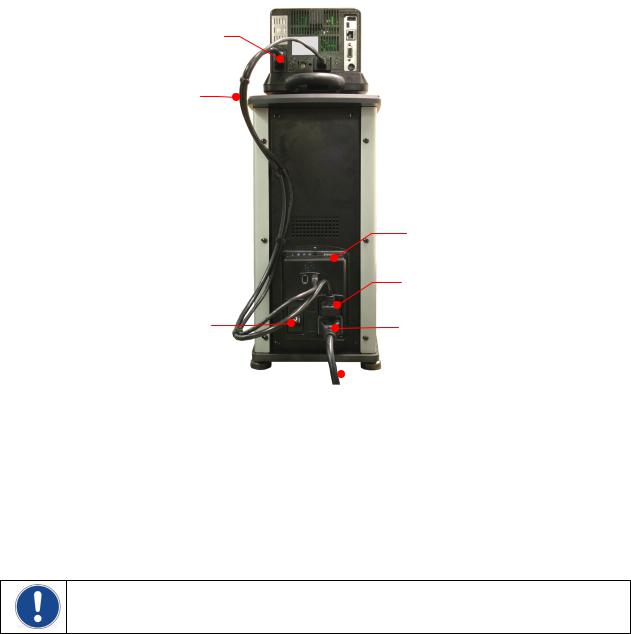
IEC Power Connection to
Refrigeration Power Module
IEC to IEC Power Cord
Refrigeration Power Module
IEC Power Connection to Controller
Power Switch / Circuit Breaker |
|
IEC Power Connection to Mains |
|
|
IEC to Mains Power Cord |
Heat Only Circulators and Open Bath Systems
Attach the 6-ft / 1.8 m power cord to the IEC electrical connection on the Temperature Controller and then plug the male connector into the Mains electrical outlet.
Place the Power Switch / Circuit Breaker on the Temperature Controller in the ON position. The LCD on the Controller will light and “Standby” will appear on the display; the PolyScience logo and the Power Key will also light.
NOTE: To conserve power when not in use, the LCD will go black about 5 seconds after “Standby” appears. The Power Key and PolyScience logo will remain lit to indicate that the Controller is energized and ready to use.
110-513 PSC/EN |
19 |
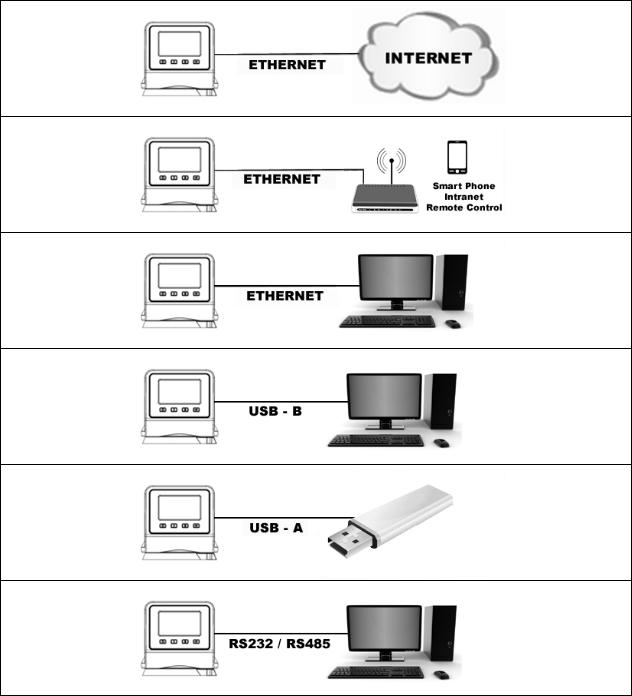
Communication
The Advanced Digital Controller features a variety of connectivity options. Following are some typical ways you can use them to monitor and control the operation of your Circulator.
110-513 PSC/EN |
20 |
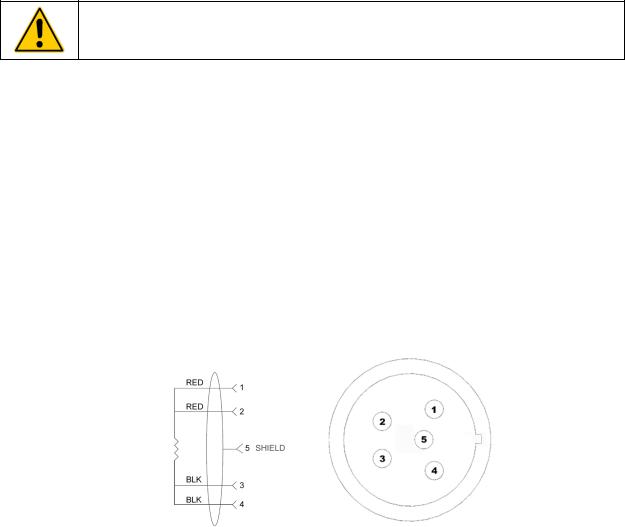
USB Communication
Two USB ports (A and B) are provided on the rear of the Temperature Controller. USB A is intended for use with a flash drive and allows you to easily log temperature data. USB B allows you to remotely monitor and control your Circulator using a computer. See Normal Operation, Selecting a Remote Communication and Control Protocol and the Technical Information section of this manual for additional information.
Ethernet
An Ethernet port is provided on the back of the Temperature Controller to enable you to connect your Circulator to a computer network. See Normal Operation, Selecting a Remote Communication and Control Protocol and the Technical Information section of this manual for additional information,
RS232 / RS485 Serial Communication
CAUTION: Always turn electrical power to the Circulator OFF before making a connection to the serial (DB9) port.
Your Circulator features RS232 / RS485 serial communication for remote data logging and control capability. A DB9 connector is provided on the rear of the Temperature Controller for this purpose. See
Normal Operation, Selecting a Remote Communication and Control Protocol and the Technical Information section of this manual for additional information.
The serial interface should be connected to a serial communication port on a remote PC using an appropriate cable. Information on the RS232 / RS485 command and communication protocol can be found in the Technical Information section of this manual.
External (P2) Temperature Probe
Your Circulator is capable of controlling temperature based on either the temperature of the internal bath or that of an external vessel or device. The connection for the optional external temperature probe is on the rear of the Temperature Controller. The Temperature Controller automatically detects the external temperature probe when it is connected. See Replacement Parts & Accessories for available lengths and part numbers.
Pin Out Diagrams — External (P2) Temperature Probe Connection
RTD SENSOR: 4 WIRE CIRCUIT, 100 OHMS @ 0 DEGREES C,
MAXIMUM OPERATING TEMPERATURE @ 200 C, CLASS A 0.003850 OHMS/DEGREES C.
110-513 PSC/EN |
21 |
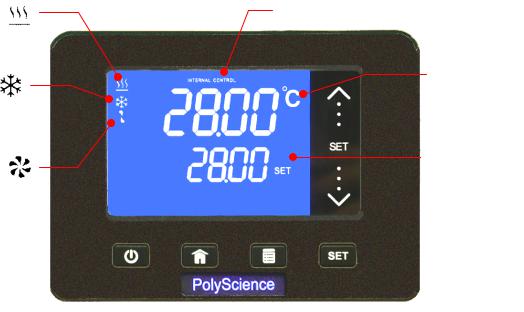
Controller Setup
Power
Press  . The Circulator will begin running, actual and set point temperatures will be displayed, and the word “SET” will be continuously lit. The pump symbol will also be lit and the heating or refrigerating symbol may be lit or flashing.
. The Circulator will begin running, actual and set point temperatures will be displayed, and the word “SET” will be continuously lit. The pump symbol will also be lit and the heating or refrigerating symbol may be lit or flashing.
Control probe
Heating symbol
Actual bath
temperature
Refrigerating symbol
Set point temperature
Circulating symbol
Internal (P1) control only – external probe (P2) not connected
110-513 PSC/EN |
22 |
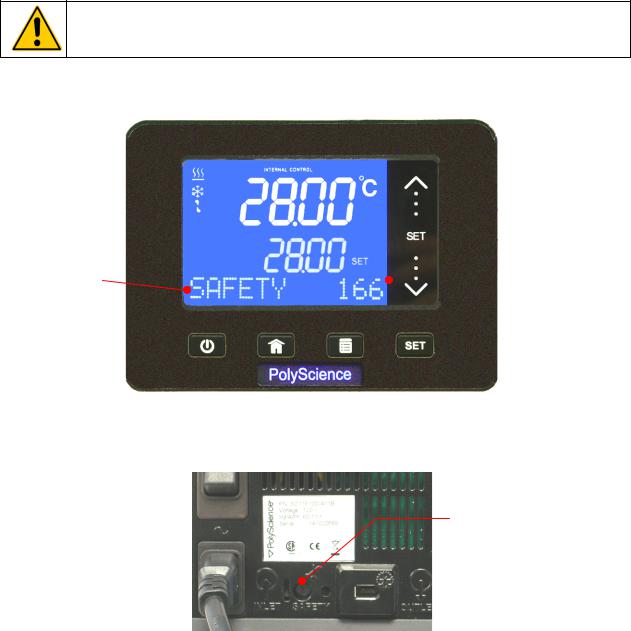
Safety Set Temperature
This is a “Do Not Exceed” temperature setting for your Circulator and is the temperature at which the heater will be turned OFF should the liquid level in the bath drop too low or the heater malfunctions. It is normally set about 5° higher than the desired operating temperature. Setting the Safety Set temperature is a simple 3-step procedure.
WARNING: The Safety Thermostat is user-adjustable from approximately 100° to 220°C / 312° to 428°F. Do not force the indicator dial beyond the stops at either end of the dial’s range.
1. Press the  key until SAFETY appears.
key until SAFETY appears.
Current Safety
Safety Set  Set Temperature
Set Temperature
sub-menu
2.Using a No.1 Philips head screwdriver, rotate the Safety Thermostat on the rear of the Temperature Controller until the desired Safety Set Temperature is displayed (clockwise to increase; counterclockwise to decrease).
Safety Set Thermostat

3. Press  to return to the main operational screen.
to return to the main operational screen.
110-513 PSC/EN |
23 |
